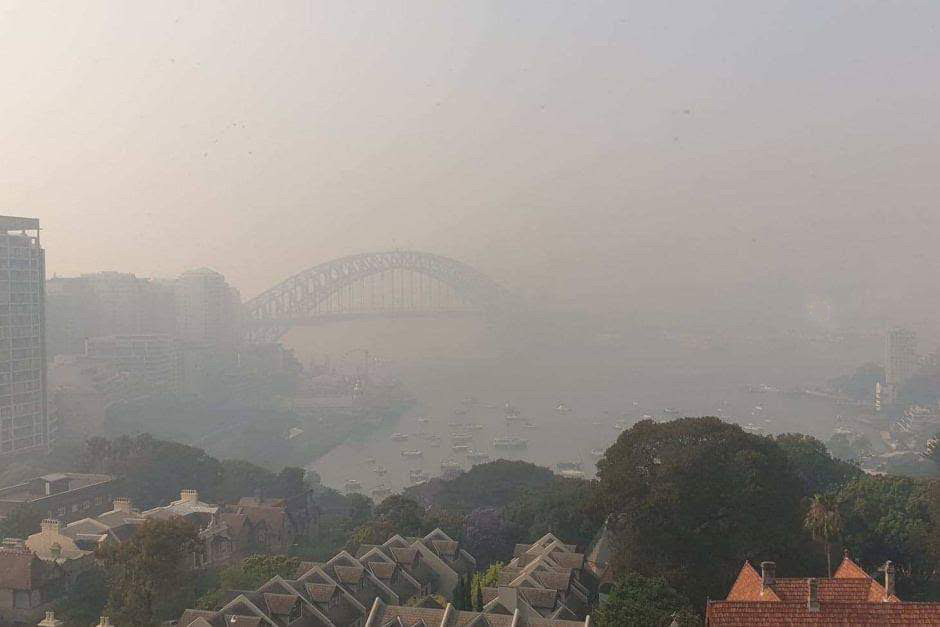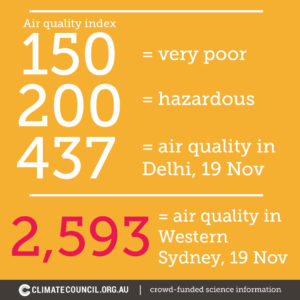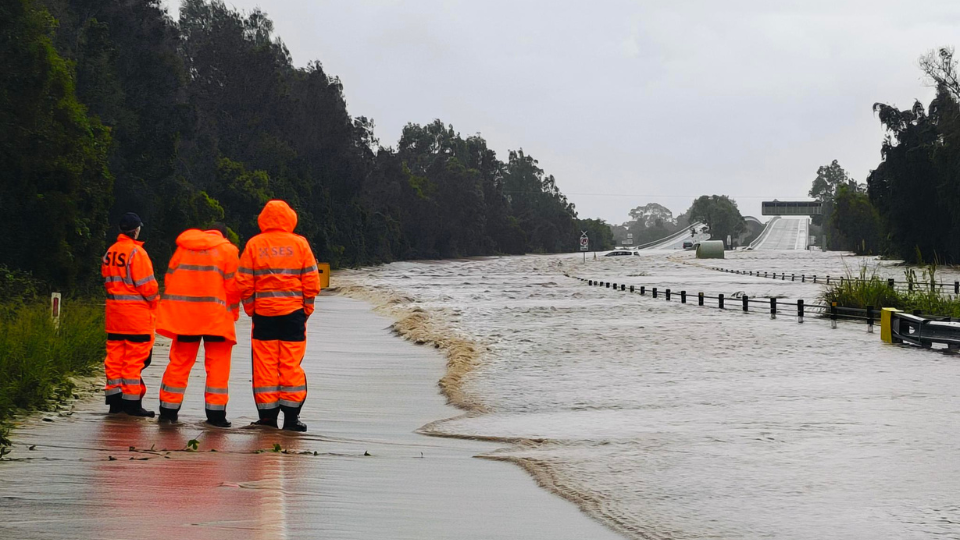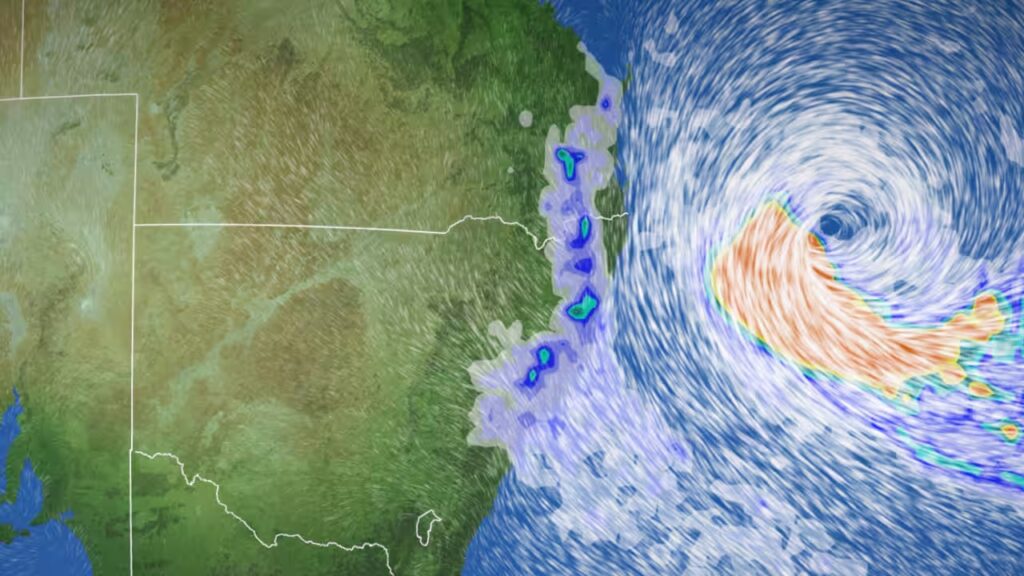Bushfire season in Australia is getting worse and worse. These fires directly affect Australians in more ways than we can count — thousands of homes have been lost, communities are being flattened, and tragically, lives have been claimed. While many brave firefighters and everyday Australians have been battling the blaze in their own backyards, others have experienced the fires from afar in the form of hazardous smoke.
Since the devastating fires of 2019-20, we’ve received a lot of questions regarding air quality and the smoke from bushfires, and the impact of climate change on air quality overall. Here, we’ve answered a few of those questions, and provided some tips on looking after your health when air quality is poor.
How does climate change impact air quality?
Climate change is caused by greenhouse gas emissions released from the burning of fossil fuels: coal, oil, and gas. Burning fossil fuels not only drives dangerous warming, it also has a significant impact on air quality and human health. In Australia, air pollution—primarily from burning fossil fuels—already causes about 3,000 premature deaths per year.
Climate change affects air quality in a range of ways, including through its influence on pollutants such as ozone and particulate matter (fine particles in the air), and aeroallergens, such as pollens and moulds. Climate change also indirectly influences particulate matter levels by increasing the frequency and severity of bushfires and dust storms in regions that are projected to be hotter and drier. Bushfires and dust storms are the main cause of extreme pollution events in areas such as Sydney.
How does poor air quality affect health?
Poor air quality, especially from bushfire smoke, creates a range of health problems, especially for those with pre-existing heart or lung conditions. Bushfire smoke contains very fine particles and carcinogens (cancer-causing substances) such as formaldehyde and benzene. Fine particulate matter is particularly damaging to health because it can travel deep into the lungs and even into the bloodstream. As smoke can travel for thousands of kilometres and cover large areas — like we’ve seen across Australia during the current bushfire crisis — large populations can be exposed to it.
Usually, healthy people can tolerate low levels of air pollution, although it can cause temporary irritation of the eyes, nose and throat. People with a heart condition or a lung condition such as asthma may experience a worsening of their symptoms. But with higher levels of air pollution, anyone can experience adverse health effects. Because of the ongoing and dense bushfire smoke blanketing some parts of Australia, the Australian Medical Association has warned that even previously healthy people may develop serious illnesses. Heat, fatigue, stress, and mental health impacts, driven by the ongoing bushfire crisis, increase health risks even further.
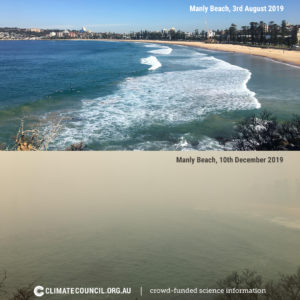
Smoke from bushfires blankets Manly Beach in Sydney
Who is most vulnerable to the impacts of bushfire smoke and poor air quality?
People with existing heart or lung conditions such as asthma, children under the age of 14, people over the age of 65, and pregnant women are among the groups most vulnerable to the impacts of bushfire smoke and poor air quality.
Anyone who develops breathlessness, wheeziness, chest tightness, or a persistent cough should seek medical attention immediately.
Recent conditions in Australian cities
New South Wales, Victoria, Queensland, Tasmania, South Australia and Western Australia have all faced dangerous air quality conditions this bushfire season. Bushfire smoke haze has been affecting the air quality for millions of people, including those in major cities such as Sydney, Melbourne, and Canberra. In November 2019, parts of Sydney experienced air quality more than 12 times the hazardous level of 200. On 1 January 2020, the air quality index in parts of Canberra (Monash) reached 4,650 — more than 23 times the hazardous threshold.
The best way to stay up to date on the conditions in your location is to consult your local air quality information. The Bureau of Meteorology provides links to smoke and air quality information for each state and territory. The free AirRater app provides information and updates on air quality covering most states and territories. Some states and territories such as NSW also provide real-time air quality updates that you can subscribe to on your phone.
How can I protect my health in poor air quality conditions?
The best way to protect your health from bushfire smoke and poor air quality is to limit your exposure when conditions are dangerous. This includes staying indoors with the doors and windows shut, and avoiding vigorous exercise outdoors. When conditions are rated as ‘hazardous’, avoid all exercise outdoors. As a rule of thumb, even healthy people should avoid exercising outside when there is visible smoke in the air. People in vulnerable groups or who are particularly sensitive to the smoke should take extra care.
While staying inside is the most effective way to protect your health, face masks rated for P2 particles can help if fitted properly. While ordinary paper masks do not protect against poor air quality, P2 (or N95) masks do filter some smoke and particulate matter. However, masks are not completely effective and require an airtight seal — for example, if you have a beard, this will create leakages around the sides of the mask. The downside is that wearing a mask can make it more difficult to breathe easily (reducing the amount of oxygen available) and the moist environment can cause bacteria to collect on masks. If you are suffering from smoke inside your home, you may also find some protection from an air purifier, although note that it must have a high-efficiency particulate air (HEPA) filter to remove particles from the air.
What must our leaders do to address our worsening air quality?
Worsening climate change is increasing the frequency and severity of bushfires and their associated impacts on health and air quality. While the Federal Government is failing to adequately respond to the climate crisis and the escalating bushfire threat, Australians from all walks of life are demanding action, including doctors and other health professionals. The main sources of air pollution are also the main sources of greenhouse gas emissions, which are driving climate change. Acting on climate change and reducing these emissions is key to ensuring healthy air for our communities.
The government must develop an urgent plan to:
- Prepare Australian communities and health and emergency services for escalating fire danger; and
- Rapidly phase out the burning of coal oil and gas, which is driving more dangerous bushfires and their associated air quality and health impacts.
You can read more about climate change and bushfires here and here.
Air quality resources by state and territory
New South Wales
Current and forecast air quality – https://www.dpie.nsw.gov.au/air-quality
Bushfire Smoke Health Information – https://www.health.nsw.gov.au/environment/factsheets/Pages/bushfire-smoke.aspx
Bureau of Meteorology Air Pollution Report – http://www.bom.gov.au/catalogue/warnings/air-pollution.shtml
Queensland
Bushfire Smoke Alert – https://www.health.qld.gov.au/news-events/health-alerts/bushfire-smoke-health-alert
Bushfire Smoke and Your Health – https://www.qld.gov.au/health/staying-healthy/environmental/after-a-disaster/bushfires/bushfire-smoke-and-your-health
Victoria
EPA Air Watch – https://www.epa.vic.gov.au/for-community/airwatch
Bushfire Smoke and Your Health – https://ref.epa.vic.gov.au/your-environment/air/smoke/bushfire-smoke-and-your-health
South Australia
Air Monitoring – https://www.epa.sa.gov.au/data_and_publications/air_quality_monitoring
SA Health – Bushfires
Western Australia
Emergency WA – https://www.emergency.wa.gov.au/
Health WA – Smoke Hazard from Bushfires – https://healthywa.wa.gov.au/Articles/S_T/Smoke-hazard-from-bushfires
Tasmania
TasALERT – http://alert.tas.gov.au/Pages/Home.aspx
Bushfire Smoke and Your Health – https://www.dhhs.tas.gov.au/publichealth/air/bushfire_smoke
Australian Capital Territory
Air Quality in the ACT: https://www.health.act.gov.au/about-our-health-system/population-health/environmental-monitoring/monitoring-and-regulating-air
ACT Air Quality Updates – https://www.health.act.gov.au/public-health-alerts
Outdoor Smoke – Health Impacts – https://www.health.act.gov.au/sites/default/files/2019-12/Outdoor%20Smoke%20%20Health%20Impacts%20Factsheet%20-%20Dec%202019%20-%20FINAL_0.pdf
Northern Territory
Bushfire Alerts and Warnings – https://denr.nt.gov.au/bushfire-information-and-management/bushfire-alerts-and-warnings/alerts-warnings
NT EPA – http://ntepa.webhop.net/NTEPA/Default.ltr.aspx
Australia Wide
Air Pollution in Australia: Real- time Air Quality Index Visual Map – https://aqicn.org/map/australia/
Air Quality Australia –
https://air-quality.com/country/australia/59ae3071?lang=en&standard=aqi_us
Global
Global forecasting of air quality (WACCM): https://www.acom.ucar.edu/waccm/forecast/

